| Oriṭa | |
|---|---|
 Oriṭa M1941 | |
| Type | Submachine gun |
| Place of origin | Romania |
| Service history | |
| In service | 1943[1]–1970s[2] |
| Used by | Romania Nazi Germany |
| Production history | |
| Designed | 1941 |
| Manufacturer | Uzinele Metalurgice Copșa Mică și Cugir |
| No. built | 6,000+ |
| Variants | Orița M1941, Orița M1948 |
| Specifications | |
| Mass | 3.45 kg (7.6 lb) without magazine 4 kg (8.8 lb) with magazine |
| Length | 894 mm (35.2 in) |
| Barrel length | 278 mm (10.9 in) |
| Cartridge | 9×19mm Parabellum[3] |
| Rate of fire | 400-600 rpm cyclic |
| Muzzle velocity | 400 m/s (1,300 ft/s) |
| Effective firing range | 200 m (656.2 ft) |
| Feed system | 25 or 32 round detachable box magazine |
| Sights | graded from 100 m (328.1 ft) to 500 m (1,640.4 ft) |
The Orița is a 9×19mm Parabellum submachine gun that was manufactured in Romania during World War II and for several years afterwards. It was named for Captain Marin Orița (Military Technical Corps, Romanian Army), who is credited in Romania with its design.[4] (Other sources describe the Orița as a joint Czech-Romanian project;[1] the Czech Leopold Jašek and the Romanian Nicolae Sterca are also considered to have contributed to its design.[2][5]) The mass production was made by CMC Uzinele Metallurgice Copșa Mică together with Cugir Arms Factory. The first version, Model 1941, entered operational service with the Romanian Army in 1943.[1] Two later improved models were the Model 1948, with a fixed wooden stock, and the rare paratrooper Model 1949, with a folding metal stock.[6] It remained in service with the Romanian Army until it was replaced in the 1960s by the more powerful Pistol Mitralieră model 1963/1965, a Romanian version of the AK-47 assault rifle. The Orița remained in service with the Romanian paramilitaries ("Gărzile Patriotice") until the 1970s.[2]
With a production rate of 666 pieces per month as of October 1942,[7] 6,000 were produced until October 1943.[8]
A small quantity of these Romanian weapons was also used by the Wehrmacht during the last two years of the Second World War.[9]
Other specifications
- Rifling: 6 right-hand grooves
Orita Carbine
A carbine version of the Orita was designed, chambered in 9×23mm Steyr. Only one prototype was built; it is preserved in the National Military Museum in Bucharest.
Notes
- 1 2 3 Axworthy & al (1995), p. 75
- 1 2 3 Plăvcan, L. & Plăvcan, D., Romanian Firepower…
- ↑ Specifications for Orița, Model 1941, are from Plăvcan, L. & Plăvcan, D., Romanian Firepower…
- ↑ König (1977), p. 229
- ↑ Anonymous, Román kézifegyverek…
- ↑ König (1977), p. 231
- ↑ Mark Axworthy, London: Arms and Armour, 1995, Third Axis, Fourth Ally: Romanian Armed Forces in the European War, 1941–1945, p. 75
- ↑ Mark Axworthy, London: Arms and Armour, 1995, Third Axis, Fourth Ally: Romanian Armed Forces in the European War, 1941–1945, p. 149
- ↑ John Walter, Guns of the Third Reich, Greenhill Books, 2004, p. 163
Sources
- Anonymous, Román kézifegyverek: Md. 1941 Orita géppisztoly (in Hungarian), retrieved 2008-01-08
- Axworthy, Mark, Cornel I. Scafeș, and Cristian Crăciunoiu. (1995) Third Axis, Fourth Ally: Romanian Armed Forces in the European War, 1941–1945. London: Arms and Armour ISBN 1-85409-267-7.
- König, Carol. Căpitanul Marin Orița—Inventator român de prestigiu din al doilea sfert al secolului al XX‑lea. Muzeul Militar Central, Studii și materiale de muzeografie și istorie militară, 10 (1977): 229–33. (in Romanian)
- Plăvcan, Liviu; Plăvcan, Dora, Romanian Firepower: 9mm Orita Model 1941 Submachine Gun, retrieved 2008-01-08.
External links
- Orița Model 1941 Technical drawing.
- Orița submachine guns Photograph from the National Military Museum of Romania.
- Romanian Orita Model 1941/48